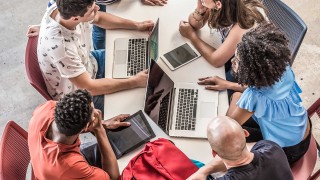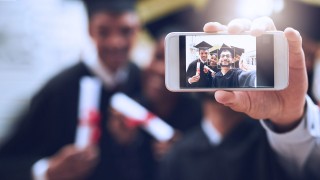Facial recognition can give students better service (and security)
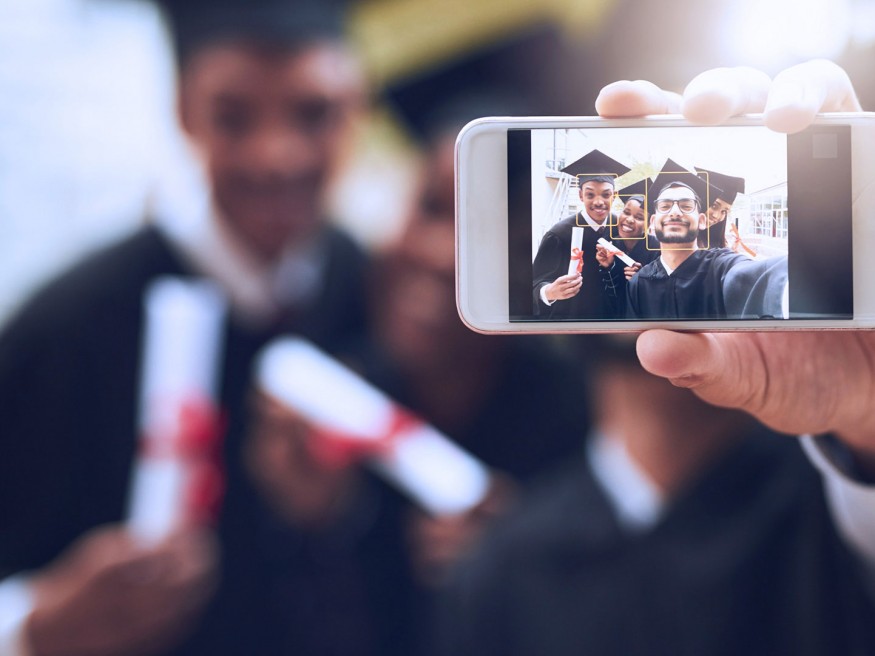
Carrying a photo id on campus may soon become a thing of the past as advances in artificial intelligence have paved the way for making facial recognition technology available and worth implementing on campus. Already, smartphone users can unlock their phone just by looking at it. On college campuses in the near future, facial recognition can enable on-the-spot classroom analytics based on audience reactions during a lecture, and better-than-ever security on campus.
To some, facial recognition can seem like an unnecessary and invasive monitoring tool. But if implemented thoughtfully by faculty and administrators, this technology can make student data more personal and powerful, without sacrificing security.
In part one of this two-part series, I'll walk through how facial recognition works and discuss the opportunities, benefits, and risks of implementing. Check out part two for recommendations on covering your cybersecurity bases and ensuring a safe and thoughtful campus implementation.
How facial recognition technology works
Since its inception among intelligence agencies in the 1960s, facial recognition technology has matured and is now poised to debut on college campuses.
How exactly does it work? Here’s a quick run-through of the technologies and techniques that, in combination, make facial recognition effective and reliable.
Facial recognition techniques
- Three-dimensional facial recognition techniques use 3-D sensors to capture the shape of a face—this works well even if the lighting level changes.
- Skin texture analysis is a technique that analyzes the texture of the skin. This methodology even helps in differentiating between identical twins.
- Some systems use thermal images of the faces using thermal cameras. This methodology can help “see through” accessories like hats, glasses, and piercings, while still closely recognizing a face. These techniques are fused to recognize a face with a great deal of accuracy.
Common facial recognition systems
- Deep Face is a system used by Facebook that leverages a nine-layer neural network to train and recognize faces based on millions of pictures posted by users.
- Apple iPhone X uses a special face recognition sensor that has two parts, “Romeo,” a module that projects around 30K infrared dots onto the face, and another module “Juliet” that reads the pattern. The pattern is then analyzed by an iPhone processor to recognize if the pattern matches the face of the owner.
Facial recognition software libraries
There are currently multiple software libraries available that can help developers build and test facial recognition applications. Google Vision API, as part of the Google Cloud Platform, and Amazon Rekognition service both provide a framework.
My team has been working on facial recognition prototypes using Google APIs. The API library does the basic work of identifying faces in a given image or a video stream. It also provides the metadata of the faces it has identified. This metadata includes landmark points in the face that help in identifying each unique face. This data is used to match against image data already stored in a database. If there’s a match, a desired program will run.
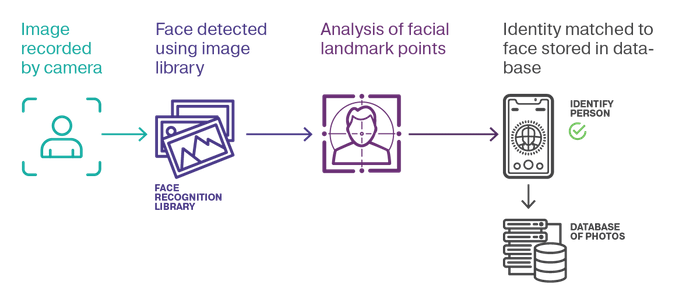
How facial recognition improves the student experience
A facial recognition system can help institutions enhance the student experience in ways both simple and complex.
A face is used as an index of identity, and it can be used for recognizing students and completing a service without requiring an action or gesture by students. A student need not swipe a card, enter a key code, or sign a sheet. Integrated camera systems can automatically recognize a student and make a database entry. In a crowded lecture hall (or a crowded online space), and in the case of accounting for all students present in a class, this can be done rapidly for every student present in a crowded lecture hall (or a crowded online space).
Learning engagement
Facial recognition technology can be programmed to recognize a wide range of nonverbal expressions and emotions. Through this, a professor can assess the emotion levels of the class to determine the parts of his lecture that are the most exciting and engaging, or where students’ attention appears to diminish. In this way, every unique face can function like a uniquely identifiable thumbprint that also speaks, through verbal and nonverbal data.
The sample dashboard below comes from a research prototype that was showcased at the Ellucian Innovation Labs during Ellucian Live 2018. It conveys facial responses measured throughout the duration of a lecture.
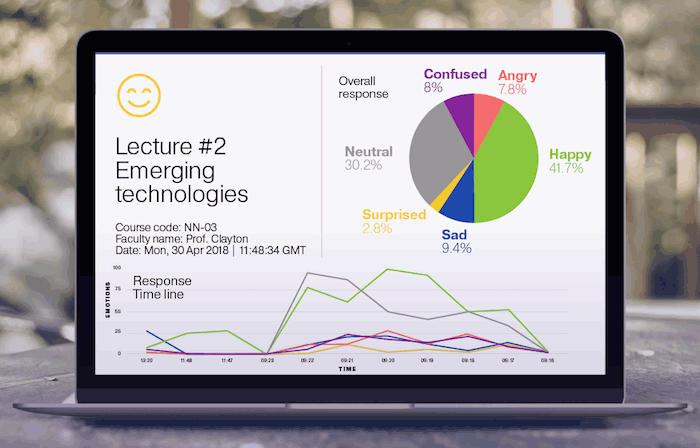
As class-engagement data of this sort comes in, week to week and semester to semester, faculty and administrators can partner to build new data models that unlock powerful insights into how students learn, what methods are most effective, and what differentiates great classes (and great teachers) from less-effective learning experiences.
Furthermore, as a student matriculates toward graduation one semester at a time, aggregate data can perhaps be used to discover learning strengths and areas of concern, enabling more tailored learning experiences that can lead each student to better outcomes.
Attendance tracking
Attendance tracking is a time-consuming manual process for institutions that still implement the practice for many reasons that include meeting academic requirements, compliance with Federal aid requirements, or measuring the engagement levels of students. For as long as this process has been the norm, faculty and the students (whether remote or in person) spend the first few minutes of each class recording attendance. Facial recognition technology offers a streamlined and automatic way to do so.
Over time, data collected from this technology could help administrators design more accommodating learning environments and experiences, while improving the effectiveness of class scheduling—i.e. administrators can see which class dates and times are most and least popular (or tend to have the most successful students), and modify schedules accordingly. If there are no formal means of tracking attendance and engagement, institutions find it difficult to implement these measurements—and surely faculty and students have better things to do at the start of class than count heads and sign names.
Security
Recently, one of the top universities in China, Beijing Normal University, implemented a facial recognition system to prevent intruders entering student dorms.
More restrictive access to locations and materials in-person and online means more privacy and more security at institutions protecting the ideas, research, and personally identifiable information (PII) of students and faculty, as well as their physical safety.
While it may be quicker or more practical for institutions to stick with more trusted tactile security measures, the security (i.e. cybersecurity) provided by facial recognition is practically a must for accessing secure systems by mobile or remote devices.
Opportunity and risk on the horizon
With facial recognition accuracy already above 97%, the technology has matured enough for institutions to begin working with attendance tracking applications. Naturally, it’s best for institutions to first dip their toes into this software—perhaps with dorm-entry systems, or by testing the capability with small audiences in a select number of classes.
But before implementing this technology, keep in mind that it may present an opportunity for a student’s likeness to be compromised, or for hackers to steal student data. Institutions will need to invest in systems and processes that ensure their data libraries are safe and secure from cyberattacks. And after all, speed and accessibility should not come at the cost of security.
In my next blog, "How higher ed can prepare for facial recognition," I share some tips for safeguarding this valuable information.
Facial recognition systems are a great alternative to plastic cards, password systems, attendance registers, and manual processes, and the technology represents an upgrade to secure systems access from mobile devices. If implemented mindfully, it’s another way for higher ed to provide students a better and more personalized digital learning experience. And it offers institutions a new layer of metrics for implementing data analytics.


